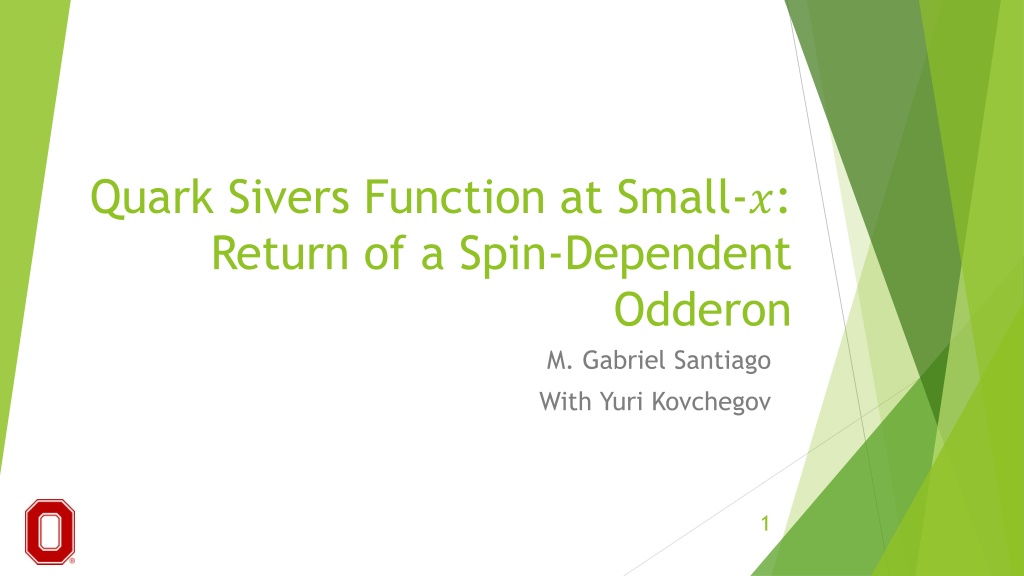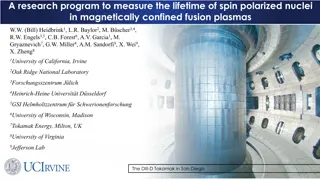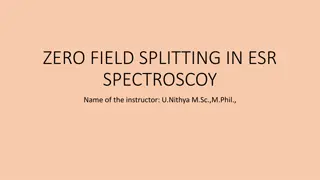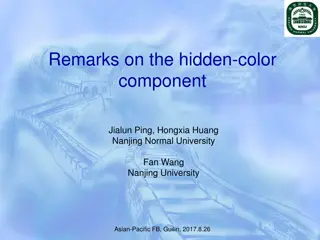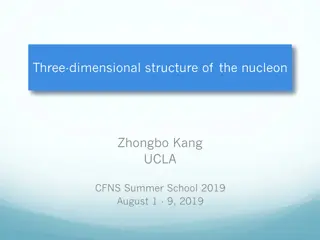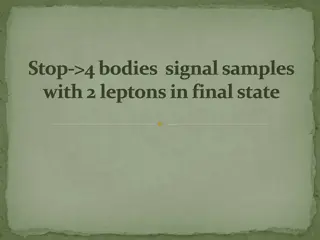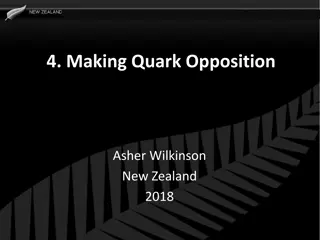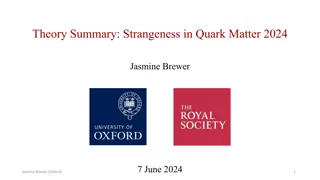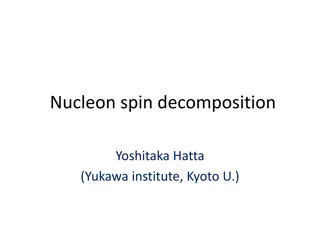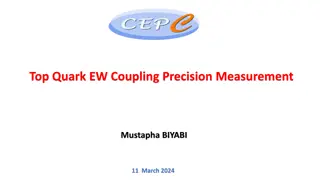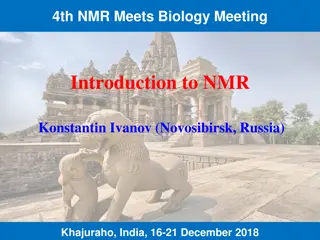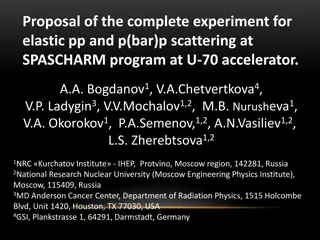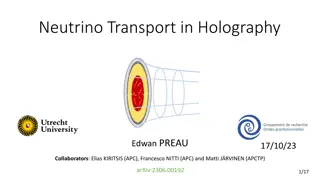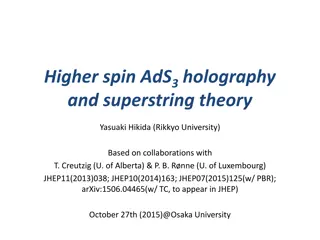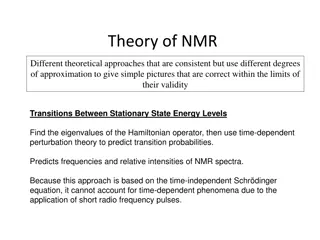Understanding Quark Sivers Function and Spin-Dependent Odderon
Quark Sivers function, a key aspect in quantum chromodynamics, plays a role in capturing orbital angular momentum and spin-orbit coupling. Spin-dependent Odderon, an elusive three-gluon exchange, contributes to cross sections in high-energy collisions. Small-$? TMDs from polarized Wilson lines provide further insights into the transverse momentum structure of hadrons. Ongoing research aims to uncover the asymptotics of these functions, shedding light on the intricate dynamics at play in particle interactions.
- Quark Sivers Function
- Spin-Dependent Odderon
- Transverse Momentum Distributions
- High-Energy Collisions
- Quantum Chromodynamics
Download Presentation

Please find below an Image/Link to download the presentation.
The content on the website is provided AS IS for your information and personal use only. It may not be sold, licensed, or shared on other websites without obtaining consent from the author. Download presentation by click this link. If you encounter any issues during the download, it is possible that the publisher has removed the file from their server.
E N D
Presentation Transcript
Quark Sivers Function at Small-?: Return of a Spin-Dependent Odderon M. Gabriel Santiago With Yuri Kovchegov 1
Quark Sivers function TMDs give the transverse momentum part of the three- dimensional structure of hadrons Finding the small-? asymptotics of these functions is an ongoing effort The Sivers TMD is the density of unpolarized quarks with transverse momentum and longitudinal momentum fraction in a proton with transverse polarization 2 M. Gabriel Santiago
Quark Sivers function The Sivers function captures orbital angular momentum and spin-orbit coupling as seen in single spin asymmetries The unintegrated quark density and Sivers function are defined by the non-local operator product Analogous TMD for gluons has known small-? asymptotics! 3 M. Gabriel Santiago
Spin-Dependent Odderon Boer et al (2016) showed that at small-? the ?-odd gluon TMDs are generated by a gauge link which couples an odderon exchange to the proton s spin The odderon is an elusive ?-odd three gluon exchange Szymanowski and Zhou (2016)showed that the odderon contributes to cross sections when the proton s wave function is asymmetric in the transverse plane The D0 and TOTEM collaborations recently announced odderon in the asymmetry between and collisions [2012.03981 [hep-ex]] Does the quark Sivers function have this same contribution? 4 M. Gabriel Santiago
Small-? TMDs from polarized Wilson lines Kovchegov and Sievert (2018) constructed the helicity and quark transversity TMDs using a high-energy scattering operator formalism The strategy is to rewrite the TMD operator definitions as dipole correlators *in or gauge 5 M. Gabriel Santiago
Small-? TMDs from polarized Wilson lines The quark correlator can be rewritten in terms of Wilson lines The polarized Wilson line makes the correlator a transverse polarized dipole 6 M. Gabriel Santiago
Small-? TMDs from polarized Wilson lines Define new polarized dipoles by adding spin-dependent interaction Helicity interaction comes at sub-eikonal level, transversity at sub-sub-eikonal 7 Define evolution for new polarized dipoles to get TMD evolution! M. Gabriel Santiago
Transverse polarized Wilson line Insert sub- or sub-sub-eikonal operator into ordinary Wilson lines 8 M. Gabriel Santiago
Transverse polarized Wilson line Full sub-sub-eikonal polarized fundamental Wilson line for TMDs which depend on the proton s transverse spin ? ?, ? 9 M. Gabriel Santiago
Small-? Sivers function Apply the formalism to rewrite the Sivers function in terms of polarized transverse Wilson lines Discarding light quark masses, the quark-quark correlator which yields the Sivers function is Only an eikonal Wilson line correlator remains! 10 M. Gabriel Santiago
Dipole Odderon In the color dipole picture, it is the antisymmetric, imaginary piece of a dipole correlator 11 M. Gabriel Santiago
Small-? Sivers = Spin-dependent Odderon! The imaginary correlator in the Sivers function is exactly the odderon amplitude, so we have Agreement with the small-? gluon ?-odd TMDs, spin-dependent odderon! Intrinsic asymmetry in the proton transverse momentum structure 12 M. Gabriel Santiago
Diquark model calculation We can estimate the small-? Sivers function in the diquark model, where the interaction between the point-particle proton ??, the quark field ?, and the scalar diquark ? is 13 M. Gabriel Santiago
Diquark model calculation Plugging the diquark model odderon into our Sivers function result gives Nonzero spin-dependent odderon! Interesting behavior as , Sivers function does not vanish 14 M. Gabriel Santiago
Outlook Small-? Sivers function is dominated by eikonal spin-dependent odderon Odderon small-? evolution is known to have a zero intercept at LO and NLO in ?? (Bartels, Lipatov, Vacca (2000), Kovchegov (2013)), at large ?? (Caron-Huot (2013)), and in supersymmetric Yang-Mills (Brower, Djuric, Tan (2009),so we expect no suppression of Sivers at very small-? Opens the possibility to see spin-dependent odderon in spin asymmetries of SIDIS (and DY) with future colliders such as EIC! 15 M. Gabriel Santiago
References D. Boer, M. G. Echevarria, P. Mulders, and J. Zhou, Phys. Rev. Lett. 116, 122001 (2016), arXiv:1511.03485 [hep-ph]. L. Szymanowski and J. Zhou, Phys. Lett. B760, 249 (2016), arXiv:1604.03207 [hep-ph]. Y. V. Kovchegov and M. D. Sievert, Phys. Rev. D99, 054032 (2019), arXiv:1808.09010 [hep-ph]. Y. V. Kovchegov and M. D. Sievert, Phys. Rev. D99, 054033 (2019), arXiv:1808.10354 [hep-ph]. V. M. Abazov et al. (D0, TOTEM), (2020), arXiv:2012.03981 [hep-ex]. J. Bartels, L. Lipatov, and G. Vacca, Phys.Lett. B477, 178 (2000), arXiv:hep-ph/9912423 [hep- ph]. Y. V. Kovchegov, AIP Conf. Proc. 1523, 335 (2013), arXiv:1212.2113 [hep-ph]. S. Caron-Huot, JHEP 05 (2015), arXiv:1309.6521 [hep-th]. R. C. Brower, M. Djuric, and C.-I. Tan, JHEP 0907, 063 (2009), arXiv:0812.0354 [hep-th]. 16 M. Gabriel Santiago
Thank You 17 M. Gabriel Santiago
